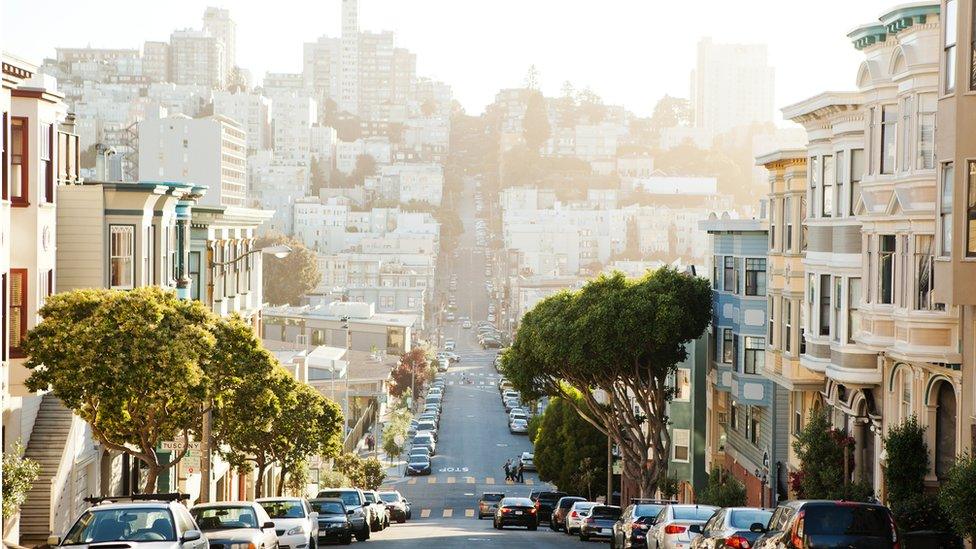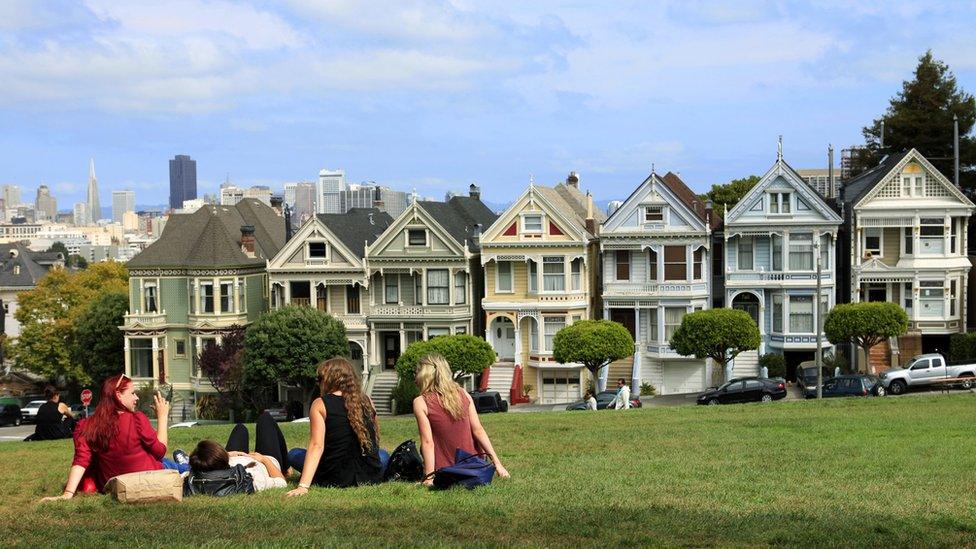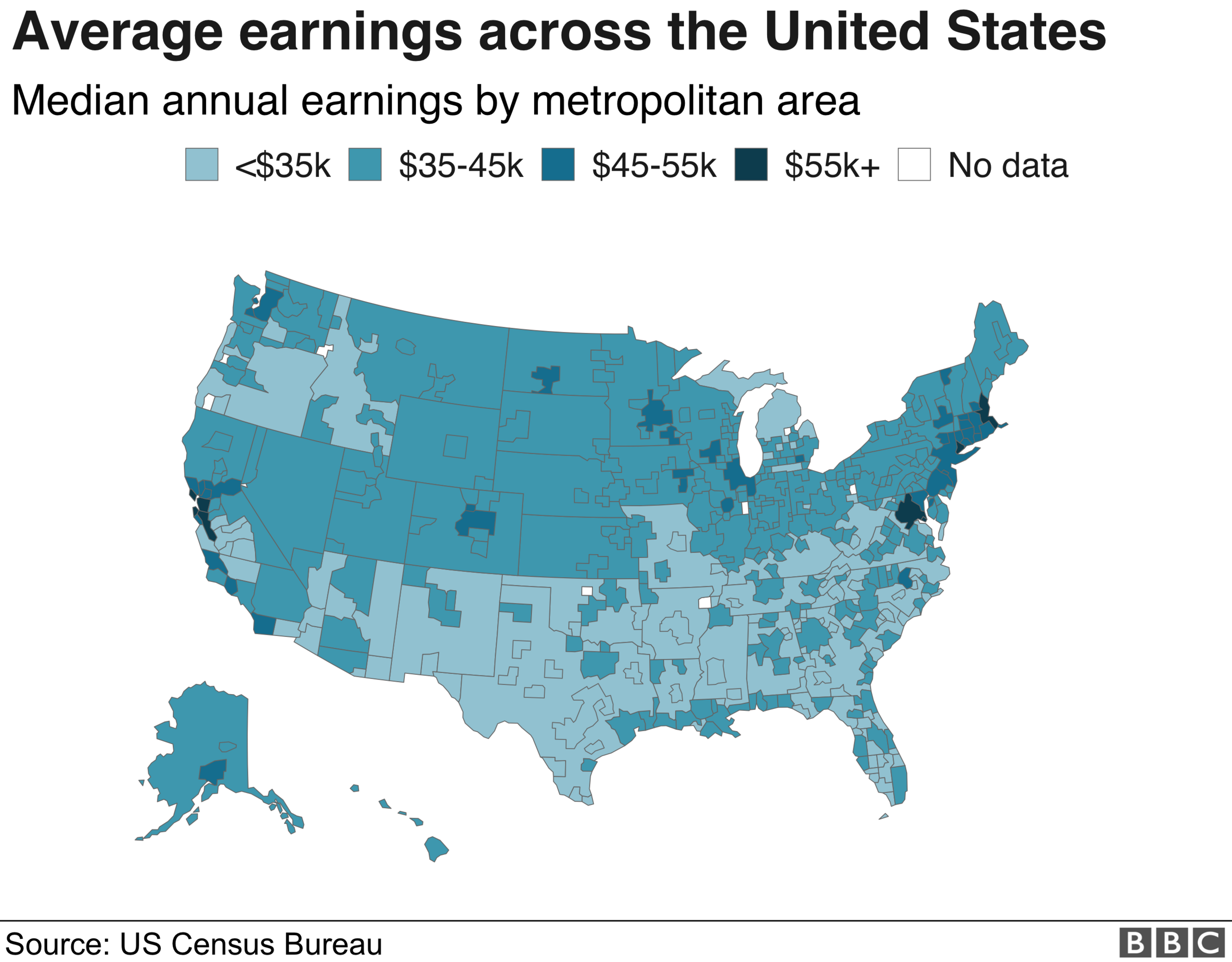San Francisco: Where a six-figure salary is 'low income'
- Published

A family getting by on $117,400 (£87,970) in one US city can now be considered 'low income', according to government figures. How can that be the case?
That workers with six-figure salaries could be considered "poor" is something that might surprise many people.
But taking into account income and housing costs that is the reality for some families - who may be eligible for housing assistance - according to a recent report from the US Department of Housing and Urban Development, external.
In San Francisco and nearby San Mateo and Marin Counties it said $117,400 for a family of four was "low income", while $73,300 (£54,900) was "very low income" - the highest figures anywhere in the country.
A look at how earnings vary across the US and between jobs illustrates what is going in the city and the country as a whole - factors explored by a new study and interactive website, external by The Hamilton Project at the Brookings Institution.
Below the poverty line

Nearly two thirds of American families of four live on less than San Francisco's "low-income" threshold of $117,400.
Across the US, the median (middle) household income for a family of four is $91,000 (£68,170). For a family of any size, the figure is $59,000 (£44,180). (Median incomes are used throughout this piece).
And, in a country of 326m, more than 40m people in families of all sizes live below the poverty line, external, which is $25,100 (£18,800) for a family of four.
Looking at all jobs, earnings are much higher in some large cities than they are in the rest of the country.

San Francisco in particular stands out.
The city has become a hub for IT and other high-tech industry - leading to an economic boom which has seen it become home to many of the country's highest-paid workers.
Between 2008 and 2016, individual earnings for full-time workers aged 25 to 64 in the San Francisco metro area, which also includes Alameda and Contra Costa counties, grew by 26% - far faster than in many other large metro areas. By 2016, earnings had risen to $63,000 (£47,200)
Of course, there are other areas of the US with high wages.
Among 25 to 64-year-olds, typical earnings for full-time workers in recent years were $65,000 (£48,670) in San Jose, $60,600 (£45,400) in Washington DC and $55,700 (£41,700) in Boston.


In high-earning places like these there are many jobs that pay well.
In San Francisco, doctors - the highest-paid occupation - can expect to earn $193,400 (£144,800). The typical chief executive or public administrator is paid $167,300 (£125,260), while software developers can expect $117,100 (£87,670).
But there are plenty of people earning much less.
The lowest-paid people in San Francisco are farm workers, who typically earn $18,500 (£13,850), while childcare workers earn $22,300 (£16,700).
Wages in other big US cities are noticeably lower.
In Detroit, for example, a doctor typically earns $144,300 (£108,000), while childcare workers receive only $15,000 (£11,230).
However, the wide variation in earnings is only part of the equation.
Living costs, particularly for housing, play a significant role in determining how far workers can stretch their earnings.
In fact, living costs in general for the San Francisco area are 25% higher than the national average.
However, as earnings are 45% higher than for the nation as a whole, many people in San Francisco are still coming out ahead.


It is when we look at housing costs specifically that the comparison is less favourable.
In many large cities, the problems of high rents and home prices have been exacerbated by strict building rules and growing income inequality.
It is high rents in San Francisco that are behind the decision to label some six-figure earning families as "low income".
For example, a fair market rent for a two-bedroom apartment in the San Francisco area is considered to be $3,121 (£2,340) per month - nearly twice the 2008 figure of $1,592 (£1,190). In Cincinnati, Ohio, the figure is $845 (£632). This difference (270%) is much larger than the difference in median family incomes (50%).

As such, affordability is a significant challenge for many people in San Francisco.
Across the US, the government typically defines a low-income family as one that earns less than 80% of the median income for families of the same size, in the same area.
But in places with unusually high housing costs the threshold can be higher.
In San Francisco, high rents have driven the government's "low income" threshold of $117,400 (£87,970) almost as high as the median income for a family of four in the area - $118,400 (£88,630).
While falling below this mark does not automatically entitle families to government housing assistance such as subsidies and public housing, it is a factor that is considered.
More important than money
But it is of course worth considering that, for many people, high prices are something that they are willing to put up with for a good quality of life.
San Francisco is certainly an expensive place to live, but good weather and a rich cultural life attract many residents.
Across the US, it is often the case that the places rated most highly for quality of life - like San Francisco and Santa Barbara in California and Honolulu in Hawaii - tend to have a high cost of living.
While families with six-figure earnings may not be "low-income" in the broadest sense, the challenge remains for expensive cities across the US to find ways to offer a good quality of life to all of their residents.
A critical look at how to make more affordable housing available might be an obvious place to start.

About this piece
This analysis piece was commissioned by the BBC from experts working for an outside organisation.
Prof Jay Shambaugh is the director, external of The Hamilton Project, external and a senior fellow in Economic Studies at the Brookings Institution.
Ryan Nunn is the policy director, external of The Hamilton Project and a fellow in Economic Studies at the Brookings Institution.
The Brookings Institution, external is a not-for-profit public policy organisation, conducting research that leads to new ideas for solving problems facing society.

Edited by Duncan Walker.